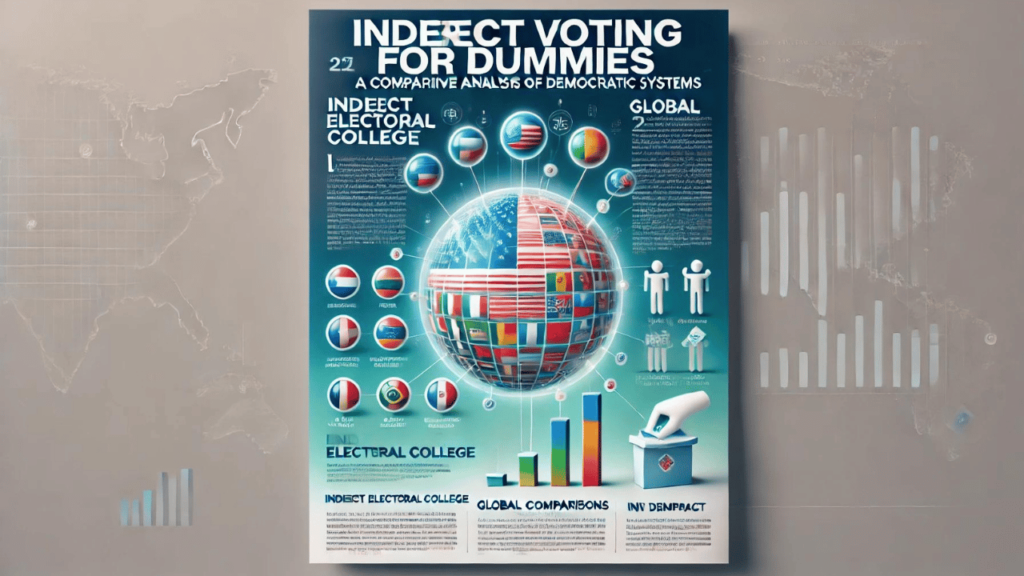Indirect voting systems, where voters elect representatives who then choose leaders on their behalf, play a crucial role in the democratic framework of various countries. This method is epitomized by the U.S. Electoral College, a quintessential model of indirect voting for dummies. Understanding these systems provides insight into the complexities and nuances of democratic governance and how different countries approach the balance between direct public influence and institutional checks.
Understanding the U.S. Electoral College
The U.S. Electoral College is a prime example of an indirect voting system designed to buffer direct democratic impulses with a layer of representative deliberation. This system was established to prevent the “tyranny of the majority,” a concept feared by many of the nation’s founders. When Americans cast their votes for President, they are technically voting for electors who then vote for the President. This mechanism is pivotal in understanding indirect voting for dummies as it encapsulates the founders’ desire to temper direct public choice with a more deliberative process to ensure qualified leadership.
REAS ALSO: The Groundbreaking Work of Domestic Violence Advocate Kim Wilson: Empowering Voices
Indirect Voting in Global Democracies
Many democratic nations utilize forms of indirect voting for dummies, implementing systems where the heads of state or government are not directly elected by the public but through representative assemblies. For instance, parliamentary democracies often have a prime minister who is the leader of the majority party and not directly elected by voters. This system is prevalent in countries such as Germany, Canada, and India, where it fosters stability and ensures that the executive leader has the legislative support necessary to govern effectively.
Electoral Systems: A Comparative Overview
In exploring indirect voting for dummies, it’s essential to discuss variations within the systems themselves. For example, while the U.S. predominantly uses a winner-take-all approach in the Electoral College, states like Maine and Nebraska utilize a proportional representation model. These differences underscore the adaptability of indirect voting systems to address issues of fairness and representation, reflecting ongoing debates about their efficacy and democratic legitimacy.
The Future of Indirect Voting Systems
As discussions about electoral reform continue, understanding the impact and nuances of indirect voting for dummies is more relevant than ever. Debates about the democratic legitimacy of the Electoral College and similar systems worldwide highlight the tension between traditional electoral mechanisms and contemporary calls for more direct forms of democracy. The evolution of these systems will likely continue as nations strive to balance historical electoral frameworks with modern democratic ideals.
Voter Disenfranchisement Concerns
One of the most significant criticisms of indirect voting systems, such as the U.S. Electoral College, revolves around the issue of voter disenfranchisement. Critics argue that indirect voting for dummies can lead to scenarios where the electoral outcome does not reflect the popular will. For example, in the United States, the winner-take-all method used by most states means that even a small margin of victory in a state can result in the complete allocation of all electoral votes to one candidate, potentially ignoring a substantial portion of the electorate. This phenomenon raises concerns about the fairness of the system and whether it truly represents the democratic choice of all citizens.
The Role of Electors and Potential for Faithless Votes
Another layer of complexity in indirect voting systems is the role of electors themselves. Electors are supposed to vote for the candidate who wins the popular vote in their state, but there have been instances of “faithless electors” who vote contrary to the popular vote. While rare, these occurrences can provoke significant legal and ethical questions about the allegiance of electors and the integrity of the electoral process. This aspect is crucial to understanding the potential pitfalls of indirect voting for dummies, as it underscores the unpredictability and human factor involved in the final decision-making process.
Comparative Efficacy and Public Trust
The efficacy of indirect voting systems is often compared to more direct democratic processes. Countries that employ a more straightforward electoral process, where leaders are elected based solely on the popular vote, tend to have higher levels of public trust in electoral outcomes. In contrast, systems that use indirect voting mechanisms, especially those that have resulted in leaders who did not win the popular vote, can suffer from reduced public confidence and increased political polarization.
Reform Movements and Alternatives
Given the criticisms and challenges associated with indirect voting systems, there have been numerous calls for reform. Movements advocating for the abolition of the Electoral College in favor of a national popular vote have gained momentum in the United States. Proponents argue that this change would simplify the voting process, enhance transparency, and ensure that every vote carries equal weight. Similar reform efforts can be observed in other countries where indirect voting mechanisms are perceived to be out of step with contemporary democratic values.
FAQs About Indirect Voting
- What is indirect voting for dummies?
- Indirect voting refers to a system where voters elect representatives who then vote on their behalf for specific leadership positions.
- Why was the Electoral College system created?
- The Electoral College was created as a compromise to balance the direct vote of the populace with a safeguard against potential majority tyranny, ensuring a qualified presidency.
- How does indirect voting affect democratic representation?
- Indirect voting can sometimes lead to outcomes where the elected leader does not have the majority of the direct popular vote, which raises questions about the system’s democratic validity.
- What are some global examples of indirect voting systems besides the U.S.?
- Countries like Germany, Canada, and India use indirect voting systems to elect leaders like the Chancellor or Prime Minister through parliamentary bodies.
- Are there calls for reforming indirect voting systems?
- Yes, there are ongoing debates and movements aimed at reforming indirect voting systems to enhance direct democratic involvement and representation in several countries, including the U.S.

